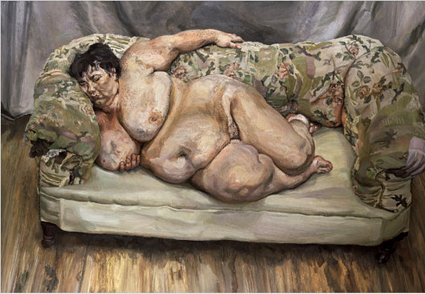Lucian Freud: Portraits, at the National Portrait Gallery.
Lucian Freud’s death last July at the age of eighty-eight means that the National Portrait Gallery’s long-gestated show of his portraits has taken on the aura of a memorial. Collectively the 100-plus pictures in the exhibition portray Freud’s unconventional coterie of friends, acquaintances and family, including his various wives and mistresses, several of his many illegitimate children, a handful of lords and ladies and assorted low-life characters including a dodgy bookmaker and a bank-robber. “The people in my life”, the artist called them; but they were also the people through which he expressed his own edgy and uneasy conception of life, so the whole show could be seen as a composite self-portrait of sorts.
The display also includes a number of the artist’s actual self-portraits. The earliest was painted in 1943, at the height of the Second World War. Clutching a mysterious feather in his left hand while gesturing enigmatically with his right, the jug-eared young Lucian Freud wears a dark jacket with matching bootlace tie and stares into space with a glassy-eyed expression on his face. Surreal yellow icebergs drift at his feet; a cartoon bird and a stick-figure of a man peer from the windows of an otherwise untenanted house. In 1946 Freud painted himself again, this time as Man with a Thistle. It is hard to say which is spikier, man or thistle. The plant’s spines are rhymed in the knifepoint triangle of the artist’s shirt-collar and the razor-sharp curls of his hair. The look in his eyes suggests an extreme, nervy wariness. Twenty years later, in the disconcertingly odd Interior with Plant, Reflection Listening (Self-Portrait) he would again associate himself with barbed foliage, cupping an ear and peeping out from between the spiked fronds of a riotously thriving...


